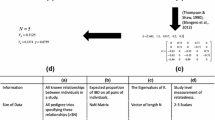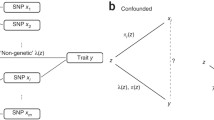Abstract
Genetic correlations (ρ g ) are frequently estimated from natural and experimental populations, yet many of the statistical properties of estimators of ρ g are not known, and accurate methods have not been described for estimating the precision of estimates of ρ g . Our objective was to assess the statistical properties of multivariate analysis of variance (MANOVA), restricted maximum likelihood (REML), and maximum likelihood (ML) estimators of ρ g by simulating bivariate normal samples for the one-way balanced linear model. We estimated probabilities of non-positive definite MANOVA estimates of genetic variance-covariance matrices and biases and variances of MANOVA, REML, and ML estimators of ρ g , and assessed the accuracy of parametric, jackknife, and bootstrap variance and confidence interval estimators for ρ g . MANOVA estimates of ρ g were normally distributed. REML and ML estimates were normally distributed for ρ g = 0.1, but skewed for ρ g = 0.5 and 0.9. All of the estimators were biased. The MANOVA estimator was less biased than REML and ML estimators when heritability (H), the number of genotypes (n), and the number of replications (r) were low. The biases were otherwise nearly equal for different estimators and could not be reduced by jackknifing or bootstrapping. The variance of the MANOVA estimator was greater than the variance of the REML or ML estimator for most H, n, and r. Bootstrapping produced estimates of the variance of ρ g close to the known variance, especially for REML and ML. The observed coverages of the REML and ML bootstrap interval estimators were consistently close to stated coverages, whereas the observed coverage of the MANOVA bootstrap interval estimator was unsatisfactory for some H, ρ g , n, and r. The other interval estimators produced unsatisfactory coverages. REML and ML bootstrap interval estimates were narrower than MANOVA bootstrap interval estimates for most H, ρ g , n, and r.
Similar content being viewed by others
References
Amemiya Y (1985) What should be done when a estimated betweengroup covariance matrix is not nonnegative definite? The Am Stat 39:112–117
Anderson RL, Crump PP (1967) Comparisons of designs and estimation procedures for estimating parameters in a two-stage nested process. Technometrics 9:499–516
Arvesen JN, Schmitz TH (1970) Robust procedures for variance component problems using the jackknife. Biometrics 26:677–686
Baker RJ (1986) Selection indices in plant breeding. CRC Press, Boca Raton, Florida
Bridges WC, Knapp SJ (1987) Probabilities of negative estimates of genetic variances. Theor Appl Genet 74:269–274
Bridges WC, Knapp SJ, Cornelius PJ (1990) Standard errors and confidence interval estimators for expected selection response. Crop Sci 31:253–255
Calvin, Dykstra RL (1991) Least squares estimation of covariance matrices in balanced multivariate variance components models. J Am Stat Assoc 86:388–395
Cameron ND, Thompson R (1986) Design of multivariate selection experiments to estimate genetic parameters. Theor Appl Genet 72:466–276
Efron B (1982) The Jackknife, the bootstrap and other resampling plans. SIAM, Philadelphia
Efron B (1987) The better bootstrap confidence intervals. J Am Stat Assoc 82:171–185
Efron B, Tibshirani R (1986) Bootstrap methods for standard errors, confidence intervals, and other measures of statistical accuracy. Stat Sci 1:54–77
Falconer DS (1981) Introduction to quantitative genetics. Longman, London
Gunsett FC, Andriano KN, Rutledge JJ (1982) Estimating the precision of estimates of genetic parameters realized from multipletrait selection experiments. Biometrics 38:981–989
Harville DA (1977) Maximum likelihood approaches to variance component estimation and to related problems. J Am Stat Assoc 72:320–388
Hill WG, Thompson R (1978) Probabilities of non-positive definte between-group or genetic covariance matrices. Biometrics 34:429–439
Johnson ME (1987) Multivariate statistical simulation. Wiley, New York
Kinderman AL (1975) Computer generation of random variables with normal and Student’s t distributions. In: Proc Stat Comp Sec Amer Stat Assoc, pp
Klotz J, Putter J (1969) Maximum likelihood estimation of multivariate covariance components for the balanced one-way layout. Ann Math Stat 40:1100–1105
Knapp SJ, Bridges WC (1988) Parametric and jackknife confidence interval estimators for two-factor mating design genetic variance ratios. Theor Appl Genet 76:385–392
Knapp SJ, Bridges WC, Yang MH (1989) Nonparametric confidence interval estimators for heritability and expected selection response. Genetics 121:891–898
Knapp SJ, Tagliani LA, Liu B-H (1991) Outcrossing rates of experimental populations of Cuphea lanceolata. Plant Breed 106:334–337
Lande R (1984) The genetic correlation between characters maintained by selection, linkage and inbreeding. Genet Res 44:309–320
Liu B-H (1990) Statistical properties of estimators of genetic correlation. PhD dissertation, Oregon State University, Corvallis (Diss Abstr #9032678)
McCutchan BG, Ou JX, Namkoong G (1985) A comparison of planned unbalanced designs for estimating heritability in perennial tree crops. Theor Appl Genet 71:536–544
Meyer K (1991) Estimating variances and covariances for multivariate animal models by restricted maximum likelihood. Genet Sel Evol 23:67–83
Miller RG (1974) The jackknife—a review. Biometrika 61:1–14
Mitchell-Olds T, Bergelson J (1990) Statistical genetics of Impatiens capensis. I. Genetic basis of quantitative variation. Genetics 124:407–415
Rao CR, Kleffe J (1988) Estimation of variance components and applications. North-Holland, Amsterdam
Reeve ECR (1955) The variance of the genetic correlation coefficient. Biometrics 11:357–374
Riska B, Prout T, Turelli M (1989) Laboratory estimates of heritabilities and genetic correlations in nature. Genetics 123: 865–871
Robertson A (1959) The sampling variance of the genetic correlation. Biometrics 15:469–485
Schenker N (1985) Qualms about bootstrap confidence intervals. J Am Stat Assoc 80:360–361
Scheinberg E (1966) The samplimg variance of the correlation coefficients estimated in genetic experiments. Biometrics 22:187–191
Schoen DJ, Clegg MT (1986) Monte Carlo studies of plant mating system estimation models:the one-pollen parent and mixedmating models. Genetics 112:927–945
Searle SR (1970) Linear models. Wiley, New York
Smith RH (1985) Maximum likelihood mean and covariance matrix estimation constrained to general positive semi-definiteness. Commun Statist-Theor Methods 14:2163–2179
Swallow WH, Monahan JF (1984) Monte Carlo comparison of ANOVA, MIVQUE, REML, and ML estimators of variance components. Technometrics 26:47–57
Tallis GM (1959) Sampling errors of genetic correlation coefficients calculated from the analysis of variance and covariance. Aust J Stat 1:35–43
Thompson R (1973) The estimation of variance and covariance components with an application when records are subject to culling. Biometrics 29:527–550
Thompson WO (1975) A comparison of designs and estimators for the two-stage nested random model. Technometrics 17:37–44
VanVleck LD, Henderson CR (1961) Empirical sampling estimates of genetic correlations. Biometrics 17:359–371
Weir BS (1990) Genetic data analysis. Sinauer Assoc, Sunderland, Massachusetts
Author information
Authors and Affiliations
Additional information
Communicated by A. L. Kahler
Rights and permissions
About this article
Cite this article
Liu, B.H., Knapp, S.J. & Birkes, D. Sampling distributions, biases, variances, and confidence intervals for genetic correlations. Theoret. Appl. Genetics 94, 8–19 (1997). https://doi.org/10.1007/s001220050375
Received:
Accepted:
Issue Date:
DOI: https://doi.org/10.1007/s001220050375




